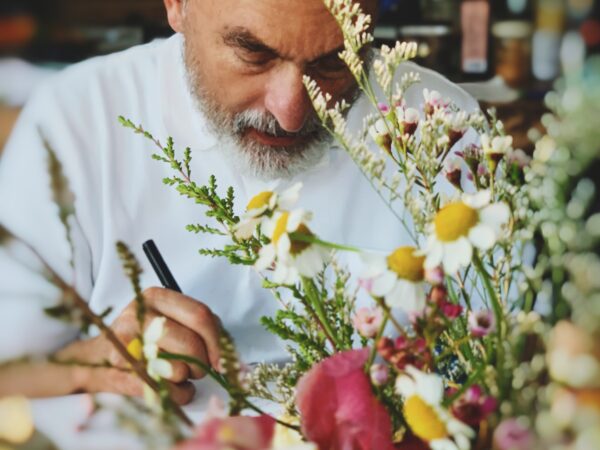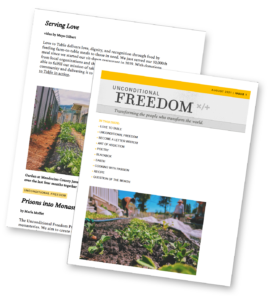At sesshin (meditation intensive) one year, perhaps 1968, Suzuki Roshi lectured about how to practice Zen. “Zen,” he said, “is like feeling your way along in the dark. You might think it would be better to have more light, to know where you are going, and to get there in a hurry; but Zen is feeling your way along in the dark.”
“You might think that it would be better to have plenty of light and to know where you are going, but then you get impatient and want to push things out of your way. When you are in the dark you become more careful and sensitive to what is happening around you.”
At the shosan ceremony which followed sesshin (each student asks a question out loud in public), I asked Suzuki Roshi, “feeling my way along in the dark… and now that sesshin is over, how about if we have a party?”
“If you do it with that spirit, it will be perfectly okay,” he said.
“Wonderful,” I thought, and started getting up from kneeling in front of him, when his voice — “the most important point” — brought my movement to an abrupt pause.
“The most important point is…” and he paused, while I prompted myself to listen intently as the words slowly came out — “is to find out… what is… the most important point.”
I thought he was going to tell me that most important point — only he had — and years later I continue to investigate this!
One of the places where I have studied this is in the kitchen, while cooking. What is the most important point? As a Buddhist there are many ready-made answers: being mindful, being silent, watching your mind, being calm and peaceful. All well and good, but did anyone say, preparing food? Or feeling your way along in the dark? We do well to study how we do what we are doing: what is the most important point? Because as Suzuki Roshi mentioned, “If I tell you something, you will stick to it…but it is not always so.”
Proverbially Buddhists often mention the importance of being mindful, “Be mindful in the kitchen while you work.” Perhaps useful, but unfortunately the word is overused and used inaccurately. When people do not pick up after themselves, they are not being mindful. When they are gossiping while cooking, that’s not mindful. In other words when someone is not doing what they should, they are not being mindful. So be mindful becomes do it right, the way you are supposed to. (And then I will not have to talk with you about how you need to behave differently — to gain my approval!)
I characterize being mindful as experiencing our experiences without judging good or bad, right or wrong. Being mindful in this fashion, we might notice dishes, crumbs, or scraps on what was formerly a clean surface — and choose to clean it up or elect to request others to clean up after themselves. Saying that the people who left these items were not mindful is another way of saying they are bad, that is wrong, and we do not approve of their behavior.
If you are not doing what I would like you to do, I won’t say that you are wrong or bad; I’ll simply note that you were not being mindful: I’m being a good Buddhist, and you are not! (I’m not judging good/bad; I’m judging not mindful.) Who gets to say? Do you want to prepare food or be a good Buddhist? And is there a way to do both? In our everyday world this is similar to the question, do we want to solicit cooperation or do we keep quiet minding our own business so that people will like us?
While offering a number of alternatives to being mindful in the kitchen, I would caution the reader to feel the way along in the dark and to investigate the most important point. In other words, find out for ourselves how to make working in the kitchen a source of spiritual awakening, home, well-being, brightness, integrity, wholeheartedness, et al.
When I asked Suzuki Roshi for his advice about working in the kitchen, he said, “When you wash the rice, wash the rice. When you cut the carrots, cut the carrots. When you stir the soup, stir the soup.” Though very similar, this is not the same as, “be mindful in the kitchen,” which makes it sound like we have two things to do: washing and being mindful, cutting and being mindful, stirring and being mindful. What would that mindfulness part look like? Probably a bit stiff, as our impulse will be to move slowly and carefully enough that only a moderate amount of energy and emotion arises to meet the circumstances. In other words, most people hear be mindful as keep ourselves in check and turn the volume down.
Yet what is magnificent and magical is finding out how to manifest the cutting of carrots with our whole body and mind; how to wash the rice with our eyes and our hands, connecting consciousness with the senses and the world — not just going through the motions. This brings me to a pivotally important point: when we stop going through the motions and manifest the stirring of soup, alive in the present moment, emotions may surface. While some Buddhists find this problematic and seemingly recommend dispassion, my suggestion is to invite our passion to cook.
Instead of tying ourselves down so that nothing volatile arises, use what is vibrant and volatile — feelings — to energize our presence in the kitchen. Invite them to handle, stir, wash, touch, scrub, scour; invite them to see, smell, taste, and delight in the play. Cooking’s temperament is a passion for life: give it a field in which to practice — put it to work. If I were to cook only when I was most loving, kind, and benevolent, I would have starved long ago. I am not telling you to act out in the kitchen. My encouragement is to turn afflictive emotions, as well as enthusiasm and exuberance, into something edible and nourishing — food.
So along with mindfulness, washing the rice when we wash the rice is also putting more emphasis on concentration, focus, attention, and energy. These actions rather blend together: Prepare food! Make it happen! Wash, cut, cook, taste, savor. Gather ourselves, as many disparate parts as we can muster. Zero in on the activity and how to do it easily, effectively, effortlessly (not just going through the motions). Give our attention to observing and perceiving rather than giving out directives and enforcing rules. Let our life force bloom and sparkle. Interact. Study how to use our bodies to do the work of cooking.
This kind of instruction accords with the Soto Zen principle on the oneness of practice and realization. The Japanese word gen can be translated as realization, manifestation, actualization — our realization becomes manifest. The title of Dogen Zenji’s Genjo Koan is often translated as Actualizing the Fundamental Point. When we make food, we are actualizing the fundamental point. We are making food real and not just talking; it’s not just a head trip — we can eat it.
Engage in what we are doing. Zen Master Dogen’s advice is to let things come and abide in our hearts. Let our hearts return and abide in things. All through the day and night. ‘Heart’ here, the Japanese shin, has often been translated as ‘mind,’ which pushes the activity up into the thinking mind, rather than abiding in the feeling heart. With our emphasis on mind, we think that the point is to establish standards and protocols, and then tell people and things how to conform to our standards.
With our hearts we can meet and connect, and out of that meeting and connecting, we respond. We bring out the best by responding implicitly from the heart with our intention. This is learning to relate with the things of this world and our own bodies/minds rather than seeking to hide out in a place where we don’t have to relate with anything. We and the world are mutually arising, and we are not in charge. While leading we follow, while following we lead.
We can master recipes to get it right and gain approval. There are no recipes for telling us what our heart knows, and precious little workable advice for trusting our hearts rather than our heads. We choose to do it — and practice finding our way in the dark.
Manufactured product says, “I’m quick. I’m easy. You won’t have to relate with me at all. Put me in the microwave, and I’ll be there for you, just the way you want me to.” Recipes say, “Do what I tell you, and everything will be okay — you too can make masterpieces (and if it’s not going to be a masterpiece don’t even bother).” To engage with the world is to study what to do with a potato, a carrot, cabbages, and bell peppers. What to do and how to do it. Are you in the dark yet?
Touch with our hands, see with our eyes, smell with our noses, taste with our tongues: let things come and abide in our hearts, let our hearts return and abide in things. Our capacity for cooking will grow and develop from our devotion to being in the dark, not knowing what to do, but carefully finding our way. We enter the kitchen and engage. We become intimate with cooking through cooking. We begin to trust our own esthetic and our close experiencing of cooking (and the sometimes uncomfortable feedback from others) starts to inform our esthetic further.

 Get access to the monthly Rehumanization Magazine featuring contributors from the front lines of this effort—those living on Death Row, residents of the largest women’s prison in the world, renowned ecologists, the food insecure, and veteran correctional officers alike.
Get access to the monthly Rehumanization Magazine featuring contributors from the front lines of this effort—those living on Death Row, residents of the largest women’s prison in the world, renowned ecologists, the food insecure, and veteran correctional officers alike.